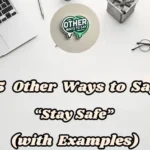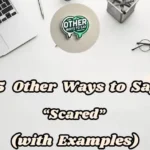The phrase “I know” is a common way to signal understanding, but it can sometimes sound abrupt or dismissive. By using a more specific phrase, you can convey a wider range of emotions, from empathy to formal agreement. Here are 15 other ways to say “I know” that you understand, each with a distinct tone and purpose.
What to Say Instead of Saying “I know”?
- I understand
- I get it
- Got it
- I see
- I’m aware
- Understood
- I follow
- I grasp
- I realize
- I comprehend
- I’m with you
- I hear you
- I catch your drift
- I’m on board
- I acknowledge
1. I understand
I understand it is a versatile and empathetic phrase that conveys genuine comprehension. It carries a warm, reassuring tone, making it ideal for both personal and professional contexts where you want to show you are truly listening and processing what someone has shared. This phrase emphasizes emotional or intellectual alignment, helping to build trust and show sensitivity.
- Example 1: “I understand that sounds really overwhelming, and I’m here for you.”
- Example 2: “I understand; the timeline for this complex project is very tight.”
2. I get it
I get it is a casual and conversational phrase that expresses quick comprehension. It has a friendly and relatable tone, perfect for informal settings among friends or close colleagues. This phrase suggests an immediate, intuitive grasp of a simple explanation or shared experience, keeping the conversation light and confirming that you are on the same page.
- Example 1: “I get it; their food is amazing, and that’s why we always go there.”
- Example 2: “I get it; this new office policy simplifies things for everyone.”
3. Got it
Got it is a concise and informal phrase that signals quick acknowledgment of information. It has a confident and efficient tone, suitable for fast-paced conversations or when receiving instructions. Using got it emphasizes brevity and a readiness to move forward, conveying a sense of assurance that you’ve immediately grasped the point.
- Example 1: “Got it, I’ll be there soon following your directions!”
- Example 2: “Got it, I’ll start on that task right now during the huddle.”
4. I see
I see is a neutral and versatile phrase that conveys understanding with a thoughtful or reflective tone. It suggests that you’ve processed the information and can visualize the point being made, making it great for discussions or explanations. This phrase adds a contemplative nuance, implying that you are actively considering the information without strong emotion.
- Example 1: “I see; your new hobby of painting sounds so creative and fulfilling.”
- Example 2: “I see; that marketing approach makes a lot of sense for our target audience.”
5. I’m aware
I’m aware that conveys knowledge or understanding with a formal and confident tone. It is often used in professional or serious contexts to confirm that you already have the information or context. This phrase is ideal for workplace discussions where you want to acknowledge your pre-existing knowledge of a situation or topic while maintaining professionalism.
- Example 1: “I’m aware that the local event was canceled; it’s such a shame.”
- Example 2: “I’m aware of the policy change; I read the memo this morning.
Related Post: 15 Other Ways to Say “I Don’t Know” (With Examples)
6. Understood
Understood is a formal and concise phrase that signals clear and complete comprehension. It carries a direct, no-nonsense tone, implying that you have fully grasped the information or directive. This phrase is ideal for professional or hierarchical settings where you want to confirm understanding efficiently and show that you are ready to act on the information.
- Example 1: “Understood; the rules of the board game are clear, so let’s start playing.”
- Example 2: “Understood; I will follow the project instructions precisely as you’ve laid them out.”
7. I follow
I follow is a conversational phrase that indicates you are keeping up with an explanation or idea. It has a friendly and engaged tone, making it suitable for casual or collaborative settings. This phrase suggests that you are actively tracking the logic or narrative, which is great for discussions and learning scenarios where you want to show you are engaged in the process of understanding a complex point.
- Example 1: “I follow; that tricky math concept makes sense now with your explanation.”
- Example 2: “I follow; the new software tool is pretty intuitive after your walkthrough.”
8. I grasp
I grasp conveys a deep understanding of a complex idea or situation. It has a thoughtful and slightly formal tone, ideal for intellectual or technical contexts. This phrase suggests that you’ve fully processed something challenging, and it emphasizes a thorough, almost effortful comprehension, highlighting mental clarity and mastery of the subject.
- Example 1: “I grasp the philosophical theory now; it’s really quite profound.”
- Example 2: “I grasp the data analysis; the patterns and trends are much clearer now.”
9. I realize
I realize indicates a sudden or newfound understanding, often with a reflective or emotional tone. It suggests an epiphany or the recognition of something that was previously unclear, making it great for conversations about insights or revelations. Using this phrase conveys a personal moment of clarity, discovery, or a fresh acknowledgment of a truth.
- Example 1: “I realize now how hard your job must be; that must be so tough.”
- Example 2: “I realize the client’s needs are urgent; we need to act fast to meet them.”
10. I comprehend
I comprehend is a formal phrase that conveys deep, intellectual understanding. It has a serious and precise tone, making it ideal for academic or technical contexts where you need to confirm a thorough grasp of complex information. This phrase emphasizes a detailed, cognitive understanding and suggests mastery of the subject matter.
- Example 1: “I comprehend the scientific concept you explained; it’s fascinating.”
- Example 2: “I comprehend the detailed budget plan; the figures add up perfectly.”
Related Post: 15 Other Ways to Say Of Course (With Examples)
11. I’m with you
I’m with you is a warm, collaborative phrase that signals both agreement and understanding. It has a supportive, friendly tone, perfect for team settings or group discussions. This phrase suggests that you are not only following the speaker’s point but are also aligned with their perspective, fostering a sense of connection and solidarity.
- Example 1: “I’m with you; let’s plan that group vacation together!”
- Example 2: “I’m with you; the new team strategy sounds solid and well-thought-out.”
12. I hear you
I hear you is an empathetic phrase that acknowledges understanding, often with a supportive tone. It is ideal for personal or emotional conversations where you want to validate someone’s feelings or perspective. Using this phrase emphasizes active listening and emotional connection, focusing on the speaker’s experience rather than just the facts.
- Example 1: “I hear you; that tough day at work sounds exhausting.”
- Example 2: “I hear you; it’s frustrating when the project gets delayed unexpectedly.”
13. I catch your drift
I catch your drift is a playful, informal phrase that indicates you understand the general idea or implied point. It has a lighthearted and humorous tone, great for casual conversations among friends or peers. This phrase conveys a relaxed, intuitive grasp of a concept, especially when the explanation is subtle or indirect.
- Example 1: “I catch your drift about the surprise party; I’ll play along and keep the secret!”
- Example 2: “I catch your drift about the new approach; let’s give it a try!”
14. I’m on board
I’m on board conveys not only understanding but also enthusiastic agreement and support for an idea or plan. It has a collaborative and positive tone, perfect for team meetings or group discussions. This phrase is ideal for situations where you want to confirm your comprehension and show a clear commitment to a shared goal.
- Example 1: “I’m on board; the family reunion schedule sounds like a lot of fun!”
- Example 2: “I’m on board with your new project idea; let’s do it!”
15. I acknowledge
I acknowledge, it is a formal phrase that confirms recognition or understanding of information. It has a professional and official tone, making it suitable for workplace or legal contexts. This phrase implies a deliberate act of noting or accepting something, perfect for conveying clear and respectful confirmation of facts or instructions in a structured exchange.
- Example 1: “I acknowledge the invitation details; I’ll follow them precisely.”
- Example 2: “I acknowledge the policy update and will comply with it immediately.”
Conclusion
By now, you’ve discovered a variety of Other Ways to Say “I Know”, allowing you to communicate with greater nuance and precision. Using these alternatives, you can convey everything from empathy to formal agreement. To continue enriching your vocabulary and enhancing your communication skills, explore the wealth of linguistic options available on the Other Ways To Say homepage.

Thomas Schneider is a language enthusiast and expert in synonyms, dedicated to exploring the beauty of words and their nuanced meanings. With a passion for linguistics and clear communication, Thomas helps readers enrich their vocabulary and understand the subtle art of word choice. Whether you’re a writer, student, or language lover, his insights offer practical tools to elevate your language skills.


